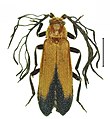Platerodrilus is a genus of beetles of the family Lycidae. They commonly appear in the literature under the name Duliticola, which is an obsolete junior synonym.[1] The females retain a larval form as adults (larviform females) and are about 40–80 mm in length. The females and larvae have a flattened, dark body with large scales over the head, resembling trilobites, hence the informal names trilobite beetle, trilobite larva or Sumatran trilobite larva. In contrast, the males are much smaller, 8–9 mm, resembling other beetles. Species are found in tropical forests of India and South-east Asia.
Although the females resemble the prehistoric trilobite, the trilobite beetle evolved approximately 47 million years ago, 200 million years after trilobites had gone extinct.[2] As only the females have this appearance the search for the species' males remained a mystery until Swedish zoologist Eric Mjoberg published a research paper describing them in 1925.[3]
Species
- "P. paradoxus group"
- Platerodrilus foliaceus Masek & Bocak, 2014
- Platerodrilus paradoxus (Mjöberg, 1925)
- "P. major group"
- Platerodrilus major Pic, 1921
- Platerodrilus ngi Masek & Bocak, 2014
- Platerodrilus wittmeri Masek & Bocak, 2014
- "P. sinuatus group"
- Platerodrilus ijenensis Masek & Bocak, 2014
- Platerodrilus luteus Masek & Bocak, 2014
- Platerodrilus maninjauensis Masek & Bocak, 2014
- Platerodrilus montanus Masek & Bocak, 2014
- Platerodrilus palawanensis Masek & Bocak, 2014
- Platerodrilus ranauensis Masek & Bocak, 2014
- Platerodrilus sibayakensis Masek & Bocak, 2014
- Platerodrilus sinabungensis Masek & Bocak, 2014
- Platerodrilus sinuatus Pic, 1921
- Platerodrilus talamauensis Masek & Bocak, 2014
- Platerodrilus tujuhensis Masek & Bocak, 2014
- Ungrouped
- Platerodrilus bicolor (Wittmer, 1966)
- =Platerodriloplesius bicolor Wittmer, 1966
- Platerodrilus crassicornis (Pic, 1923)
- =Platrilus crassicornis (Pic, 1923)
- Platerodrilus hirtus (Wittmer, 1938)
- =Platrilus hirtus (Wittmer, 1938)
- Platerodrilus korinchiana
- Platerodrilus robinsoni Blair, 1928
- Platerodrilus ruficollis (Pic, 1942)
- =Falsocalochromus ruficollis Pic, 1942
- =Duliticola hoiseni Wong, 1996[5]
- Platerodrilus bicolor (Wittmer, 1966)
- Specimens of Platerodrilus
-
P. palawanensis, adult male
-
P. sinabungensis, adult male
-
P. talamauensis, adult male
-
P. sp.
-
P. sp.
-
P. sp.
-
P. sp.
References
- ^ Bocak, Ladislav; Masek, Michal (2014). "The taxonomy and diversity of Platerodrilus (Coleoptera, Lycidae) inferred from molecular data and morphology of adults and larvae". ZooKeys (426): 29–63. doi:10.3897/zookeys.426.7398. PMC 4137290. PMID 25147457.
- ^ "Bizarre-Looking Beetle Has an Even Weirder Sex Life". Science. 2016-10-27. Archived from the original on March 7, 2021. Retrieved 2023-03-16.
- ^ a b Mjöberg, Eric (1925). "The mystery of the so-called "trilobite larvae" or "Perty's larvae" definitely solved" (PDF). Psyche: A Journal of Entomology. 32 (3): 119–157. doi:10.1155/1925/19784.
- ^ Duliticola paradoxa. (eol.org)
- ^ Wong, A.T.C. (1996). "A new species of neotenous beetle, Duliticola hoiseni (Insecta: Coleoptera: Cantharoidea: Lycidae) from Peninsula Malaysia and Singapore". Raffles Bulletin of Zoology. 41 (1): 173–187.
External links














Recent Comments